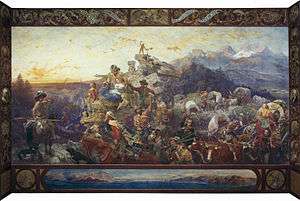Mineral painting

Westward the Course of Empire Takes Its Way mural was made using stereochromy technique
Mineral painting also known as Stereochromy is a mural painting technique that uses a water glass based paint.
The original technique was called Stereochromy where pigments were applied to plaster or stone and sealed with water glass to preserve and enhance the colors.[1][2] The name was first used about 1825 by Johann Nepomuk von Fuchs and Schlotthaurer,[3] but then improved in the 1880's by Adolf Wilhelm Keim and renamed as mineral painting[4][5] or Keim's process.
See also
References
- ↑ "Westward the Course of Empire Takes Its Way". Architect of the Capitol | United States Capitol. Retrieved 30 August 2018.
- ↑ "Stereochromy - definition, etymology and usage, examples and related words". www.finedictionary.com. Retrieved 30 August 2018.
- ↑ Doerner, Max (1984). The Materials of the Artist and Their Use in Painting: With Notes on the Techniques of the Old Masters, Revised Edition (First ed.). Harcourt Brace Jovanovich. p. 311. ISBN 9780156577168.
- ↑ "Mineral painting - CAMEO". cameo.mfa.org. Retrieved 30 August 2018.
- ↑ Mayer, Ralph. A Dictionary of Art Terms and Techniques, Harper and Row Publishers, New York, 1969
This article is issued from
Wikipedia.
The text is licensed under Creative Commons - Attribution - Sharealike.
Additional terms may apply for the media files.